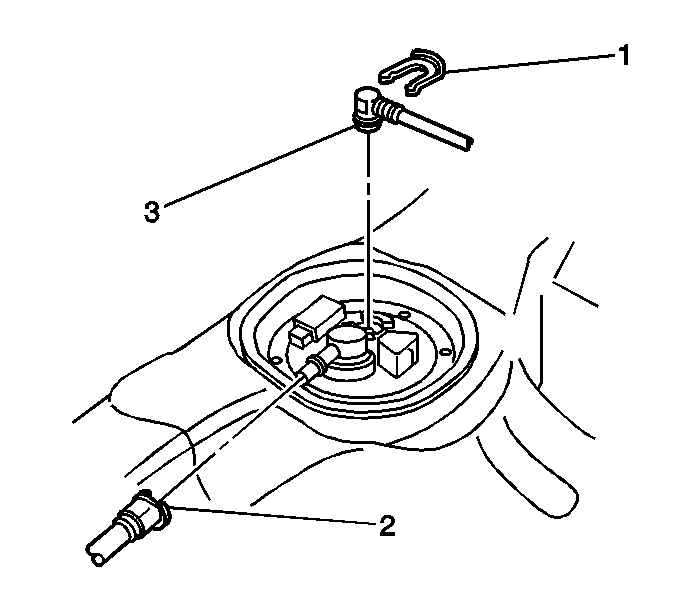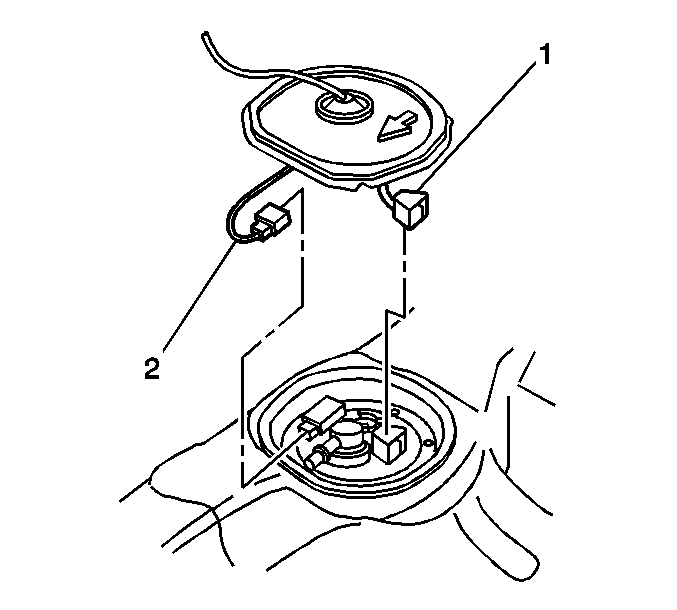Removal Procedure
Caution: Provide additional support when a vehicle is on a hoist in the following
ways:
• Before removing parts, support the opposite end. This helps prevent
the vehicle from slipping off. • Before removing major components, chain the vehicle frame to the
hoist pads at the same end as the removal. This helps avoid a tip-off.
Notice: The fuel tank equipped with ORVR components require special handling. Follow all instructions for servicing the fuel tank as specified in the service procedures. Damage to the fuel system components and the failure to meet the Federal Regulations may result from incorrect servicing of the fuel tank.
- Drain the fuel tank. Refer to Fuel Tank Draining .
- Raise and suitably support the vehicle. Refer to Lifting and Jacking the Vehicle in General Information.
- Remove the catalytic converter and intermediate pipe assembly from the vehicle. Refer to Catalytic Converter Replacement in Engine Exhaust.
- Remove the two left side bolts (1) and the three right side bolts (3) from the rear exhaust heat shield (2).
- Remove the rear exhaust heat shield (2) from the underbody.
- Remove the two bolts (1) securing the parking brake cable (2) on the left side of the vehicle.
- Remove the two bolts (1) securing the parking brake cable (2) on the right side of the vehicle.
- Disconnect the fuel supply line. Refer to Plastic Collar Quick Connect Fitting Service .
- Loosen the fuel filler hose clamp (1).
- Disconnect the fuel filler hose (2) from the fuel tank.
- Disconnect the filler pipe vent line (1) from the fuel tank (2).
- Disconnect the ORVR vent line (1) from the fill limiter vent valve (FLVV) by pinching both sides of the hose connector.
- Disconnect the filler pipe vent line (1) from the FLVV (2).
- Disconnect the EVAP vapor line (1) from the EVAP canister by pinching both sides of the hose connector.
- Support the fuel tank with a transmission jack or other suitable fixture.
- Remove the four bolts (1) and the two fuel tank straps (2) from the vehicle.
- Remove the fuel tank (3) from the vehicle.
- If replacing the fuel tank, remove all lines, hoses, and the FLVV, and install on the replacement fuel tank.










Installation Procedure
- Install the fuel tank (3) to the vehicle.
- Install the two fuel tank straps (2) to the vehicle with the four bolts (1).
- Connect the EVAP vapor line (1) to the EVAP canister.
- Connect the filler pipe vent line (1) to the FLVV (2).
- Connect the ORVR vent line (1) to the FLVV.
- Connect the filler pipe vent line (1) to the fuel tank (2).
- Connect the fuel filler hose (2) to the fuel tank.
- Secure the fuel filler hose (2) to the fuel tank with the hose clamp (1).
- Connect the fuel supply line. Refer to Plastic Collar Quick Connect Fitting Service .
- Secure the parking brake cable (2) on the right side of the vehicle with two bolts (1).
- Secure the parking brake cable (2) on the left side of the vehicle with two bolts (1).
- Install the rear exhaust heat shield (2) to the vehicle underbody.
- Secure the rear exhaust heat shield (2) with the two left side bolts (1) and the three right side bolts (3).
- Install the catalytic converter and intermediate exhaust pipe assembly to the vehicle. Refer to Catalytic Converter Replacement in Engine Exhaust.
- Lower the vehicle.
- Install the fuel tank vapor line (2) to the fuel sender fitting.
- Install the fuel supply line (3) to the fuel sender fitting.
- Secure the fuel supply line (3) with the retaining clip (1).
- Connect the fuel sender electrical connector (1) to the fuel sender assembly.
- Connect the FTP sensor electrical connector (2) to the fuel sender assembly.
- Add fuel to the fuel tank.
- Connect the negative battery cable.
- Pressurize the fuel system and check for leaks.
- Inspect the butyl caulk seal for the fuel sender access panel. Replace any missing butyl caulk as necessary.
- Install the access panel to the rear seat floor.
- Relocate the carpet under the seat and the left sill plate area.
- Install the sill plate to the left side door opening.
- Install the rear seat bottom cushion. Refer to Rear Seat Cushion Replacement in Seats.

Notice: Use the correct fastener in the correct location. Replacement fasteners must be the correct part number for that application. Fasteners requiring replacement or fasteners requiring the use of thread locking compound or sealant are identified in the service procedure. Do not use paints, lubricants, or corrosion inhibitors on fasteners or fastener joint surfaces unless specified. These coatings affect fastener torque and joint clamping force and may damage the fastener. Use the correct tightening sequence and specifications when installing fasteners in order to avoid damage to parts and systems.
Tighten
Tighten the bolts to 39 N·m (29 lb ft ).






Tighten
Tighten the bolts to 5.4 N·m (48 lb in).

Tighten
Tighten the bolts to 5.4 N·m (48 lb in).

Tighten
Tighten the bolts to 5.4 N·m (48 lb in).


Tighten
Tighten the retainer for the negative battery cable terminal to 15 N·m
(11 lb ft).
